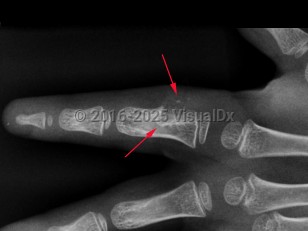Periosteal chondroma in Child
Alerts and Notices
Important News & Links
Synopsis
A rare, benign cartilage tumor that typically occurs in the long tubular bones, but also commonly develops in the proximal humerus and short tubular bones of the hands. Periosteal chondroma develops on the surface of the bone, the periosteum, a membrane covering the bone. The tumor may develop in children and adults.
The precise cause is unknown. Patients with periosteal chondroma are typically asymptomatic. In some patients, symptoms include pain, swelling, palpable mass, or broken bone. Pain as a symptom may be an indication of a malignant tumor. In most cases, periosteal chondromas do not spread to other body parts, but they may continue to grow; some may become cancerous in adulthood.
Surgical excision of the tumor is curative.
The precise cause is unknown. Patients with periosteal chondroma are typically asymptomatic. In some patients, symptoms include pain, swelling, palpable mass, or broken bone. Pain as a symptom may be an indication of a malignant tumor. In most cases, periosteal chondromas do not spread to other body parts, but they may continue to grow; some may become cancerous in adulthood.
Surgical excision of the tumor is curative.
Codes
ICD10CM:
D16.9 – Benign neoplasm of bone and articular cartilage, unspecified
SNOMEDCT:
9266000 – Juxtacortical chondroma
D16.9 – Benign neoplasm of bone and articular cartilage, unspecified
SNOMEDCT:
9266000 – Juxtacortical chondroma
Best Tests
Subscription Required
References
Subscription Required
Last Updated:01/18/2016
Periosteal chondroma in Child

